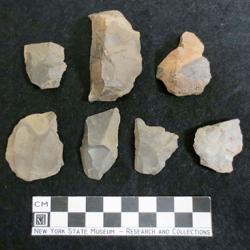The 12-year collaboration has provided UAlbany students first-hand experience with Archaeological fieldwork, site management, and research project development. In turn, the Museum has been able to document and house rare artifacts, laboratory notes and data that will be held in trust for the People of the State of New York for future exhibition and research. Additionally, the field school has also had a focus on public engagement and education through public open-houses and week-long teacher workshops.
Archaeology Staff Receive University at Albany's President's Award

New York State Museum Archaeology staff recently received the University at Albany’s President’s Award for Exemplary Public Engagement in recognition of the joint Museum-University archaeological field school at the Pethick Site in Schohaire County, New York. New York State Archaeologist, Christina Rieth, and John Hart, Director of Research & Collections, along with colleagues from the University at Albany Anthropology Department, were recognized for "providing exemplary publicly engaged teaching and service through the continued excavation of [the Pethick Site], the creation of opportunities for engaged research for undergraduate and graduate students, and the involvement of the community in the discovery and preservation of the area's history." Awardees included Jessica Watson, a University at Albany Ph.D. student who is a NYS Museum Ph.D. fellow and Steve Moragne, a University at Albany Ph.D. student who works for the Museum’s Cultural Resource Survey Program. Both have served as field directors for several years.
Dating back over 6,000 years, the Pethick Site, has revealed evidence of four major cultural occupations: (1) 4,000-3,000 B.C.; (2) 1000 B.C.-A.D. 300; (3) A.D. 1300-1400; and (4) the mid-19th century. From the original hunter-gatherers who left behind evidence of stone tools to villagers who constructed permanent homes and crafted pottery, smoking pipes and bone awls, the 350,000+ artifacts they left behind serve to document and paint a picture of the unique lives of those who, over the span thousands of years, once called the Pethick site, “home”.







